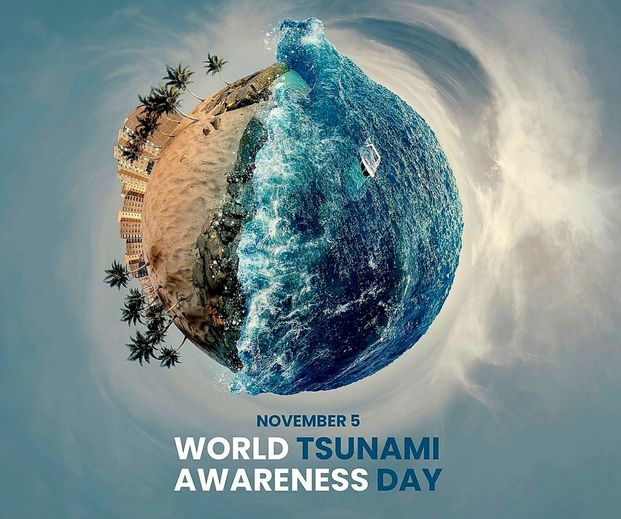🌏 Introduction: Understanding the Silent Giant — Tsunamis
Tsunamis are among nature’s most devastating and unpredictable disasters. One moment the sea is calm, and the next, a towering wall of water crashes into life as we know it. They are not just natural events, but powerful reminders of the planet’s might and our need to be informed, prepared, and resilient.
To raise awareness, encourage preparedness, and promote global cooperation, World Tsunami Awareness Day is observed every year on November 5th.
Let’s explore the history, importance, and impact of this crucial international observance.
📜 History of World Tsunami Awareness Day
World Tsunami Awareness Day was officially designated by the United Nations General Assembly in December 2015. The inspiration behind selecting November 5th lies in a centuries-old story of resilience and proactive thinking from Japan.
The “Inamura-no-hi” Story:
In 1854, a Japanese farmer named Hamguchi Goryo noticed the signs of an approaching tsunami after an earthquake. To alert his fellow villagers, he set fire to his harvested rice sheaves (“inamura”) to draw them uphill. His quick thinking saved countless lives. This act of wisdom is now known as “Inamura-no-hi” or “The Burning of the Rice Sheaves”, symbolizing early warning and evacuation.
Inspired by this story, the UN adopted November 5th as a day to:
Spread awareness of tsunami risks
Promote community resilience
Encourage global cooperation on disaster risk reduction
📅 Timeline: Evolution of Global Tsunami Preparedness
| Year | Event |
|---|---|
| 1854 | “Inamura-no-hi” story from Japan |
| 2004 | Indian Ocean Tsunami claims 230,000+ lives across 14 countries |
| 2005 | UN launches the Hyogo Framework for Action |
| 2015 | UN designates World Tsunami Awareness Day (WTAD) |
| 2016 | First official global observance of WTAD |
| 2020s | Emphasis shifts to Early Warning Systems & Education |
🌐 Important Facts About Tsunamis
Tsunami comes from Japanese: “tsu” (harbor) + “nami” (wave).
The Indian Ocean Tsunami (2004) was the deadliest in recorded history.
90% of tsunamis are caused by underwater earthquakes.
Tsunamis can travel at speeds of up to 800 km/h (as fast as a jet).
Waves can be less than a meter high in deep water but rise to over 30 meters near shores.
Asia-Pacific is the most tsunami-prone region due to tectonic plate activity.
Over 700 million people live in low-lying coastal areas at risk.
UNESCO’s Ocean Decade (2021–2030) includes tsunami resilience as a core mission.
❓ FAQs About World Tsunami Awareness Day
Q1. Why is World Tsunami Awareness Day celebrated on November 5?
It commemorates Japan’s historic “Inamura-no-hi” incident and promotes global awareness and readiness.
Q2. How do tsunamis occur?
Mostly due to undersea earthquakes, but they can also result from volcanic eruptions, landslides, or glacier calving.
Q3. What are signs of a potential tsunami?
A strong or long earthquake
Sudden rise or fall in sea level
Loud ocean roar (like a jet engine)
Q4. How can I stay safe during a tsunami?
Move to higher ground immediately
Stay away from the coast after shaking stops
Follow official warnings, don’t wait for visual confirmation
Q5. How can schools and communities prepare?
Drills, emergency kits, tsunami hazard maps, and early warning systems are key components of readiness.
🌍 Significance of World Tsunami Awareness Day
🌐 Global Impact:
In the last 100 years, 58 tsunamis have claimed over 260,000 lives.
The 2004 tsunami alone accounted for nearly 60% of all tsunami deaths in this period.
🎯 Purpose of WTAD:
Educate the public on early warning signs and escape routes
Promote infrastructure safety (e.g., tsunami-resistant buildings)
Foster international cooperation for disaster preparedness
Empower children, youth, and local communities through education
🌿 Observance: How Is It Celebrated?
World Tsunami Awareness Day is not about fear, but preparedness. Here’s how it’s observed globally:
✅ Activities and Initiatives:
School drills & evacuation exercises
Seminars and workshops on disaster readiness
Social media campaigns with #TsunamiDay and #BeTsunamiSmart
Government alerts and civil defense awareness drives
Fundraisers and donation campaigns for tsunami-affected regions
📍 Countries with Regular Participation:
Japan (model in tsunami education)
Indonesia, India, Sri Lanka (frequently affected)
USA, Chile, New Zealand, Fiji
💡 Focus on Sustainable Development:
The UN integrates WTAD with goals under the Sendai Framework for Disaster Risk Reduction and SDGs — especially Goal 11 (Sustainable Cities) and Goal 13 (Climate Action).
💬 World Tsunami Awareness Day Wishing Messages
Here are some meaningful ways to wish and raise awareness:
🌊 “On this World Tsunami Awareness Day, let’s pledge to protect lives with knowledge.”
🌊 “Preparedness saves lives. Spread awareness, not panic.”
🌊 “A small wave of awareness today can prevent a tsunami of destruction tomorrow.”
🌊 “Let’s honor the resilience of survivors by building safer communities.”
🌊 “Stay alert, stay safe. Nature warns — we must listen.”
🧠 Importance in Our Life and Society
🚨 Personal Importance:
Being tsunami-aware means you can protect yourself and your family in coastal regions.
It’s not just about reacting, but about preparing proactively.
🏘️ Social Importance:
Promotes community resilience and cooperation.
Reduces loss of life, property, and psychological trauma during disasters.
🏛️ National Importance:
Reduces the burden on disaster relief agencies and governments.
Enables infrastructure and education systems to evolve toward safer standards.
🧭 Daily Life Impacts
Even if you don’t live by the sea, tsunami awareness can:
Inspire emergency preparedness (first aid, go-bags, alert apps)
Encourage community volunteering
Lead to smarter coastal tourism decisions
Instill a culture of listening to science and natural signs
It also emphasizes earthquake readiness, which is linked with tsunami risk.
📌 Key Takeaways
World Tsunami Awareness Day is observed on November 5 every year.
Inspired by Japan’s “Inamura-no-hi” story of saving lives with foresight.
Educates people on tsunami risks, signs, and survival strategies.
Aims to build resilience at personal, community, and global levels.
Every prepared person = one less potential victim.
❤️ Conclusion: Awareness is the Greatest Shield
In a world where natural disasters are becoming more frequent and extreme, awareness is not an option — it’s a responsibility. World Tsunami Awareness Day reminds us that we are not helpless in the face of nature. With education, preparation, and cooperation, we can minimize damage and maximize survival.
Let us honor those we’ve lost by ensuring no one else is caught unprepared.
Because when the next wave comes, knowledge may be our only lifeboat.








